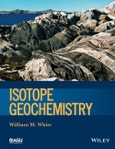Table of Contents
Preface xi
About the companion website xiii
Chapter 1: Atoms and nuclei: their physics and origins 1
1.1 Introduction 1
1.2 Physics of the Nucleus 2
1.3 Radioactive Decay 12
1.4 Nucleosynthesis 16
Chapter 2: Decay systems and geochronology I 32
2.1 Basics of Radioactive Isotope Geochemistry 32
2.2 Geochronology 36
2.3 The K-Ar-Ca System 39
2.4 The Rb-Sr System 47
2.5 The Sm-Nd System 50
2.6 The Lu-Hf System 56
2.7 The Re-Os System 61
Chapter 3: Decay systems and geochronology II: U and Th 72
3.1 Introduction 72
3.2 Pb-Pb Ages and Isochrons 7
3.3 Zircon Dating 77
3.4 U-decay Series Dating 83
Chapter 4: Geochronology III: other dating methods 101
4.1 Cosmogenic Nuclides 101
4.2 Fission Tracks 114
Chapter 5: Isotope cosmochemistry 125
5.1 Introduction 125
5.2 Cosmochronology 126
5.3 Stardust and Isotopic Anomalies in Meteorites 146
5.4 Oxygen Isotope Variations and Nebular Processes 151
5.5 Exposure Ages of Meteorites 154
Chapter 6: Radiogenic isotope geochemistry of the mantle 161
6.1 Introduction 161
6.2 Isotope Geochemistry of the Earth’s Mantle 163
6.3 Balancing Depleted Mantle and Crust 172
6.4 Mantle Plume Reservoirs 179
6.5 Geographic Variations in Mantle Isotopic Composition 187
6.6 The Subcontinental Lithosphere 189
6.7 U-Series Isotopes and Melt Generation 193
Chapter 7: Radiogenic isotope geochemistry of the continental crust and the oceans 205
7.1 Introduction 205
7.2 Growth of the Continental Crust Through Time 205
7.3 Isotopic Composition of the Continental Crust 217
7.4 Other Approaches to Crustal Composition and Evolution 224
7.5 Subduction Zones 226
7.6 Radiogenic Isotopes in Oceanography 231
Chapter 8: Stable isotope geochemistry I: Theory 246
8.1 Introduction 246
8.2 Notation and Definitions 246
8.3 Theory of Mass Dependent Isotopic Fractionations 247
8.4 Mass Independent Fractionation 260
8.5 Hydrogen and Oxygen Isotope Ratios in the Hydrologic System 262
8.6 Isotope Fractionation in the Biosphere 265
Chapter 9: Stable isotope geochemistry II: High temperature applications 277
9.1 Introduction 277
9.2 Equilibrium Fractionations Among Minerals 277
9.3 Stable Isotope Composition of the Mantle 282
9.4 Oxygen Isotopes in Magmatic Processes 288
9.5 Oxygen Isotopes in Hydrothermal Systems 298
9.6 Sulfur Isotopes and Ores 305
Chapter 10: Stable isotope geochemistry III: Low temperature applications 316
10.1 Stable Isotopes in Paleontology, Archeology, and the Environment 316
10.2 Stable Isotopes in Paleoclimatology 326
10.3 The Carbon Cycle, Isotopes, and Climate 342
Chapter 11: Unconventional isotopes and approaches 364
11.1 Introduction 364
11.2 Applications of Isotopic Clumping 365
11.3 Mass Independent Isotope Fractionations 368
11.4 Isotopes of Iron and Molybdenum 370
11.5 Isotopes of Copper and Zinc 377
11.6 Isotopes of Boron and Lithium 383
11.7 Isotopes of Magnesium and Calcium 392
11.8 Silicon Isotopes 400
11.9 Chlorine Isotopes 404
Chapter 12: Noble gas isotope geochemistry 418
12.1 Introduction 418
12.2 Helium 422
12.3 Neon 426
12.4 Argon 429
12.5 Krypton 431
12.6 Xenon 432
12.7 Implications of Noble Gas Isotope Ratios for the Origin and Evolution of the Earth 436
Appendix: Mass spectrometry 453
A.1 Sample Extraction and Preparation 453
A.2 The Mass Spectrometer 453
A.2.1 The ion source 454
A.2.2 The mass analyzer 455
A.2.3 The detector 457
A.3 Accelerator Mass Spectrometry 458
A.4 Analytical Strategies 459
A.4.1 Correcting mass fractionation 459
A.4.2 Deconvolution of results 461
A.4.3 Isotope dilution analysis 461
Notes 462
References 463
Problems 463
Index 465








